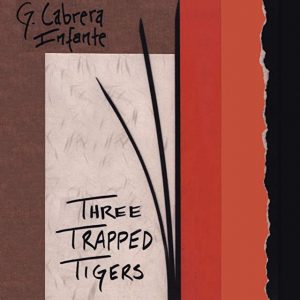
Three Trapped Tigers
by G. Cabrera Infante
translated by Suzanne Jill Levine
Dalkey Archive Press
dalkeyarchive.com
“Cabrera Infante’s masterpiece, Three Trapped Tigers is one of the most playful books to reach the U.S. from Cuba. Filled with puns, wordplay, lists upon lists, and Sternean typography—such as the section entitled “Some Revelations,” which consists of several blank pages—this novel has been praised as a more modern, sexier, funnier, Cuban Ulysses.
Centering on the recollections of a man separated from both his country and his youth, Cabrera Infante creates an enchanting vision of life and the many colorful characters found in steamy Havana’s pre-Castro cabaret society.” —dalkeyarchive.com
Essay by Suzanne Jill Levine
Guillermo Cabrera Infante’s Tres tristes tigres (Three Sad Tigers translated into Three Trapped Tigers) was a subversively groundbreaking masterpiece when it came out in the mid-1960s. It became a book all Cubans read aloud (and after Fidel Castro banned the book in a repressive act of censorship, it has become an underground classic for generations). A vast fragment recalling the nightlife fauna of Havana before the revolution, a Cuban Satyricon, this book was the first work to turn “Cuban” into a literary language—rich with slang and tongue-twisters (beginning with the title), wordplays, polyglot puns and Joycean dislocutions—a multi-ethnic Cuban Spanish that is ultimately Havanan. Living in the island-city of his exile, London from 1965 until his death in 2005, Guillermo Cabrera Infante, originally a journalist and a film critic in his native country, set out, in writing this book, to counter the alienation of exile by bringing the voices, humor, choteo of Havana to life.
Cabrera Infante and I as translating collaborators on TTT (which he called it as if it were an explosive bomb), or “closelaborators” (a term he invented), found that we shared the city-wise language of American movies and a Groucho Marxist sense of verbal non-sense whose literary antecedent could be found in Lewis Carroll and his looking-glass world. Returning to English, one of the sources of the source, signifies betraying the original’s critique of the language of the exploiter, but also, finally, exploiting or cannibalizing the exploiter. Cabrera Infante, in explaining the process of translating TTT—he and I actually reworked the first translation, which he had done in collaboration with a British translator—told an interviewer that I brought to TTT: that sense of humor characteristic of New York Jews, which is based on play upon words and confronts reality with strict verbal logic.
“Nothing was closer to my purpose in TTT than the philosophy of life expressed by the Marx brothers, and in Jill Levine my three Marxistigers had met their Margaret Dumont! While by day Jill Levine-Dumont was busy destroying with alice aforethought the remains of the stiff-upper-and-underlips, the sometimes metaphrastic construction of the English version of TTT, by night I went on building my construction of a phrase, of a word, of a phoneme—and even went so far as to treat proper names as subjects of linguistic experiments, as I did in Spanish.”
Gaining access to the mind of a genius of language such as Cabrera Infante makes us realize one of the most valuable ways in which a translator enriches her own language is by being a good critic, by choosing wisely and wildly the writers s/he translates, as in the case of this brilliant and engaging work.
Rita Guibert, “Interview: Guillermo Cabrera Infante,” Seven Voices. (New York: Knopf, 1972), 414.
